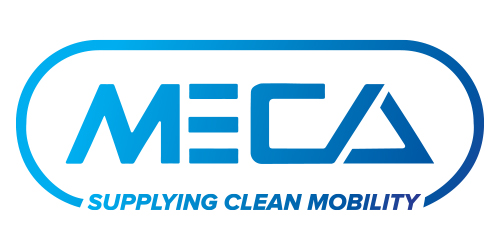What is Retrofit?
Diesel engines are important power systems for onroad and offroad vehicles. These reliable, fuel-efficient, high torque engines power many of the world’s heavy-duty trucks, buses, and nonroad vehicles. While diesel engines have many advantages, they have the disadvantage of emitting significant amounts of particulate matter (PM) and the oxides of nitrogen (NOx) into the atmosphere. Diesel engines also emit toxic air pollutants. Health experts have concluded that pollutants emitted by diesel engines adversely affect human health and contribute to acid rain, ground-level ozone and reduced visibility. Studies have shown that exposure to diesel exhaust causes lung damage and respiratory problems and there is increasing evidence that diesel emissions may cause cancer in humans.
Companies that manufacture emission controls have responded to the challenge of reducing the air pollution from diesel engines. Through their efforts, cost-effective retrofit technologies have been developed to reduce harmful emissions. Within the various mobile source sectors (e.g., mining and materials handling, trucking, urban bus and school bus, ports, and construction), diesel retrofit technologies have demonstrated their ability to significantly reduce unwanted emissions at reasonable costs without jeopardizing vehicle performance.
Both the U.S. EPA and the California ARB have created diesel retrofit verification programs as a means to thoroughly evaluate the PM emission reduction capabilities and durability of a variety of diesel emission control strategies. Verification ensures that emission reductions achieved by a control strategy are both real and durable and that production units in the field are achieving emission reductions which are consistent with their verification. For a current list of EPA and ARB verified technologies, go to: epa.gov/cleandiesel/verification/verif-list.htm and www.arb.ca.gov/diesel/verdev/vt/cvt.htm, respectively.
Diesel Emission Reduction Strategies
Retrofit
Typically, diesel retrofit involves the addition of an emission control device to remove emissions from the engine exhaust. Retrofits can be very effective at reducing emissions, eliminating up to 90 percent of pollutants in some cases. Some examples of emission control devices used for diesel retrofit include diesel oxidation catalysts, diesel particulate filters, NOx catalysts, selective catalytic reduction, and exhaust gas recirculation. Devices to control crankcase emissions also exist.
Repower
Repowering involves replacing an existing engine with a new engine. This strategy is most effective for use in diesel-powered equipment with a useful life longer than that of the engine. Repowering provides an opportunity to install a new engine (or a new engine equipped with exhaust emission controls) that meets much lower emission standards than the original engine, often in conjunction with fuel economy benefits and lower maintenance costs. Repowering can also include converting diesel-powered equipment to electrical power.
Rebuild
All diesel equipment requires periodic maintenance. Routine maintenance and repairs help to ensure that engines operate at maximum performance and emission rates do not exceed the designed standard. Major maintenance intervals provide an opportunity to have the engine rebuilt using more modern, cleaner parts and exhaust emission controls that provide an immediate emission reduction benefit.
Refuel
A variety of alternative fuels can be used in diesel engines. Some require little or no modification to the engine while others require engine conversion or replacement. Some of the alternative fuels include emulsified diesel, biodiesel, natural gas, propane and ethanol. In addition to these fuels, use of diesel fuel with lower sulfur content can help to reduce emissions.
Replace
Replacement involves retiring higher polluting equipment from service before it would otherwise be retired. Newer equipment that meets more stringent emission standards is purchased to replace the retire equipment, sometimes in conjunction with retrofit devices or alternative fuels.
Diesel Retrofit Emission Control Technologies
Diesel Oxidation Catalysts (DOCs)
The diesel oxidation catalyst (DOC) has become a leading retrofit control strategy in both the onroad and nonroad sectors throughout the world, reducing not only PM emissions but also CO and HC emissions. Using oxidation catalysts on diesel-powered vehicles is not a new concept. Oxidation catalysts have been installed on over 250,000 off-road vehicles around the world for over 30 years. Over 1.5 million oxidation catalysts have been installed on new heavy-duty highway trucks since 1994 in the U.S. These systems have operated trouble free for hundreds of thousands of miles. Oxidation catalysts have been retrofitted on over 750,000 on-road and off-road vehicles worldwide. Oxidation catalysts can be used not only with conventional diesel fuel, but have also been shown effective with biodiesel and emulsified diesel fuels, ethanol/diesel blends and other alternative diesel fuels.
In most applications, a diesel oxidation catalyst consists of a stainless steel canister that contains a honeycomb structure called a substrate or catalyst support. There are no moving parts, just large amounts of interior surface area. The interior surfaces are coated with catalytic metals such as platinum or palladium. It is called an oxidation catalyst because the device converts exhaust gas pollutants into harmless gases by means of chemical oxidation. In the case of diesel exhaust, the catalyst oxidizes CO, HCs, and the liquid hydrocarbons adsorbed on carbon particles. In the field of mobile source emission control, liquid hydrocarbons adsorbed on the carbon particles in engine exhaust are referred to as the soluble organic fraction (SOF)- the soluble part of the particulate matter in the exhaust. Diesel oxidation catalysts are efficient at converting the soluble organic fraction of diesel particulate matter into carbon dioxide and water. A conceptual diagram of a diesel oxidation catalyst is shown in Figure 1.
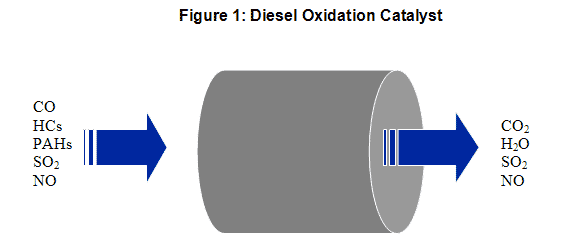
The level of total particulate reduction is influenced in part by the percentage of SOF in the particulate. For example, a Society of Automotive Engineers (SAE) Technical Paper (SAE No. 900600) reported that oxidation catalysts could reduce the SOF of the particulate by 90 percent under certain operating conditions, and could reduce total particulate emissions by up to 40 to 50 percent. Reductions of 20 to 35 percent are typical of newer model year engines. Destruction of the SOF is important since this portion of the particulate emissions contains numerous chemical pollutants that are of particular concern to health experts.
Oxidation catalysts have proven effective at reducing particulate and smoke emissions on older vehicles. Under the U.S. EPA’s urban bus rebuild/retrofit program, five manufacturers certified diesel oxidation catalysts as providing at least a 25 percent reduction in PM emissions for in-use urban buses. Certification data also indicates that oxidation catalysts achieve substantial reductions in CO and HC emissions. Currently, under the ARB and EPA retrofit technology verification processes, several technology manufacturers have verified diesel oxidation catalysts as providing at least a 25 percent reduction in PM emissions.
Diesel Particulate Filters (DPFs)
As the name implies, diesel particulate filters remove particulate matter in diesel exhaust by filtering exhaust from the engine. They can be installed on vehicles or stationary diesel engines. Since a filter can fill up over time, engineers that design filter systems must provide a means of burning off or removing accumulated particulate matter. A convenient means of disposing of accumulated particulate matter is to burn or oxidize it on the filter when exhaust temperatures are adequate. By burning off trapped material, the filter is cleaned or “regenerated”. Filters that regenerate in this fashion cannot be used in all situations.
In some nonroad applications, disposable filter systems have been used. A disposable filter is sized to collect particulate for a working shift or some other predetermined period of time. After a prescribe amount of time or when backpressure limits are approached, the filter is removed and cleaned or discarded. To ensure proper operation, filter systems are designed for the particular vehicle and vehicle application.
Filter Material. A number of filter materials have been used in diesel particulate filters including: ceramic and silicon carbide materials, fiber wound cartridges, knitted silica fiber coils, ceramic foam, wire mesh, sintered metal structures, and temperature resistant paper in the case of disposable filters. Collection efficiencies of these filters range from 50 to over 90 percent. Filter materials capture particulate matter by interception, impaction and diffusion. Filter efficiency has rarely been a problem with the filter materials listed above, but work has continued to: 1) optimize filter efficiency and minimize back pressure, 2) improve the radial flow of oxidation in the filter during regeneration, and 3) improve the mechanical strength of filter designs. Figure 2 provides a diagram of a typical high-efficiency, wall-flow filter system. High-efficiency, wall-flow filters have demonstrated the ability to reduce diesel particulate emissions by more than 90 percent in retrofit applications.
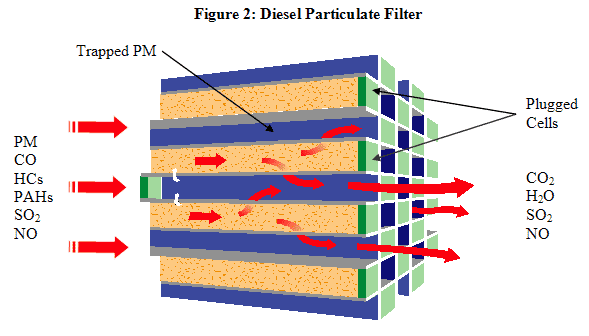
In the figure, particulate-laden exhaust enters the filter from the left. Because the cells of the filter are capped at the downstream end, exhaust cannot exit the cell directly. Instead, exhaust gas passes through the porous walls of the filter cells. In the process, particulate matter is deposited on the upstream side of the cell wall. Cleaned exhaust gas exits the filter to the right.
Regeneration. Many techniques can be used to regenerate a diesel particulate filter. Some of these techniques are used together in the same filter system to achieve efficient regeneration. Both on- and off-board regeneration systems exist. The major regeneration techniques are listed below.
- Catalyst-based regeneration using a catalyst applied to the surfaces of the filter. A base metal or precious metal coating applied to the surface of the filter reduces the ignition temperature necessary to oxidize accumulated particulate matter.
- Catalyst-based regeneration using an upstream oxidation catalyst. In this technique, an oxidation catalyst is placed upstream of the filter to facilitate oxidation of nitric oxide (NO) to nitrogen dioxide (NO2). The nitrogen dioxide reacts with the collected particulate, substantially reducing the temperature required to regenerate the filter.
- Fuel-borne catalysts. Fuel-borne catalysts reduce the temperature required for ignition of trapped particulate matter. These can be used in conjunction with both passive and active filter systems.
- Air-intake throttling. Throttling the air intake to one or more of the engine cylinders can increase the exhaust temperature and facilitate filter regeneration.
- Post top-dead-center (TDC) fuel injection. Injecting small amounts of fuel in the cylinders of a diesel engine after pistons have reached TDC introduces a small amount of unburned fuel in the engine’s exhaust gases. Fuel can also be injected into the exhaust pipe. This unburned fuel can then be oxidized in the particulate filter to combust accumulated particulate matter.
- On-board fuel burners or electrical heaters. Fuel burners or electrical heaters upstream of the filter can provide sufficient exhaust temperatures to ignite the accumulated parcticulate matter and regenerate the filter.
- Off-board electrical heaters. Off-board regeneration stations combust trapped particulate matter by blowing hot air through the filter system.
The experience with catalyzed filters indicates that there is a virtually complete reduction in odor and in the soluble organic fraction of the particulate, but some catalysts may increase sulfate emissions. Companies utilizing these catalysts to provide regeneration for their filters have modified catalyst formulations to reduce sulfates emissions to acceptable levels. Ultra-low sulfur diesel fuel (15 ppm sulfur maximum) is now available in the U.S. and has greatly facilitated these efforts.
In some situations, installation of a filter system on a vehicle may cause a very slight fuel economy penalty. This fuel penalty is due to the backpressure of the filter system. As noted above, some filter regeneration methods involve the use of fuel burners and to the extent those methods are used, there will be an additional fuel economy penalty. Many filter systems, however, have been optimized to minimize, or nearly eliminate, any noticeable fuel economy penalty. Experience in the New York City Transit program and in the San Diego school bus program has shown that fuel penalties for filters are zero or less than one percent. During the required retrofit technology verification protocols established by either the U.S. EPA or the California ARB, fuel penalties have been documented at about 1 percent for high efficiency filter systems.
Flow-Through Filters or Partial Diesel Particulate Filters
Flow-through filter technology is a relatively new method for reducing diesel PM emissions. Flow-through filters employ catalyzed metal wire mesh structures or tortuous flow, metal foil-based substrates with sintered metal sheets to reduce diesel PM. Technologies verified to date employ catalysts and/or fuel-borne catalysts to oxidize diesel soot as the exhaust flows through these more turbulent flow devices. This technology is expected to be more widely applicable than high efficiency filters because it is much less likely to plug under unfavorable conditions such as high engine-out PM emissions. Flow-through filters are capable of achieving PM reduction of about 30 to 75 percent.
A flow-through filter based on a tortuous metal foil substrate that contains sintered metal foil sheets is currently offered in Europe as a retrofit technology for a range of late-model diesel passenger cars. This metal foil-based filter is offered by one engine manufacturer in Europe on a family of new heavy-duty diesel engines. A similar flow-through metal filter substrate has recently been verified as a Level 2 technology by ARB with PM reduction of greater than or equal to 50 percent. Catalyzed wire mesh flow-through filter retrofit technologies have also been verified by both ARB and EPA for a range of onroad engine applications. Thus far, there have been limited commercial use of retrofit flow-though filters but there is an increasing interest in this technology due to its ability to significantly reduce PM emissions from older, “dirtier” diesel engines.
Selective Catalytic Reduction (SCR)
SCR has been used to control NOx emissions from stationary sources for over 15 years. More recently, it has been applied to select mobile sources including trucks, marine vessels, and locomotives. Applying SCR to diesel-powered vehicles provides simultaneous reductions of NOx, PM, and HC emissions.
An SCR system uses a metallic or ceramic wash-coated catalyzed substrate, or a homogeneously extruded catalyst and a chemical reductant to convert nitrogen oxides to molecular nitrogen and oxygen in oxygen-rich exhaust streams like those encountered with diesel engines. In mobile source applications, an aqueous urea solution is usually the preferred reductant. In some cases ammonia has been used as the reductant in mobile source retrofit applications. The reductant is added at a rate calculated by an algorithm that estimates the amount of NOx present in the exhaust stream. The algorithm relates NOx emissions to engine parameters such as engine revolutions per minute (rpm), exhaust temperature, backpressure and load. As exhaust and reductant pass over the SCR catalyst, chemical reactions occur that reduce NOx emissions. A typical layout for a retrofit SCR system for highway vehicle is shown in Figure 4. In this system a DPF is followed by an SCR catalyst for combined reductions of both diesel PM and NOx.
Open loop SCR systems can reduce NOx emissions from 75 to 90 percent. Closed loop systems on stationary engines can achieve NOx reductions of greater than 95 percent. SCR systems reduce HC emissions up to 80 percent and PM emissions 20 to 30 percent. They also reduce the characteristic odor produced by a diesel engine and diesel smoke. Like all catalyst-based emission control technologies, SCR performance is enhanced by the use of low sulfur fuel. Low sulfur fuel is not a requirement, however. SCR catalysts may also be combined with DOCs or DPFs for additional reductions of PM emissions. Combinations of DPFs and SCR generally require the use of ultra-low sulfur diesel to achieve the highest combined reductions of both PM and NOx. Application of SCR to vehicles and equipment with transient operating conditions offers special challenges and it may not be appropriate for all vehicle applications. Care must be taken to design a SCR system for the specific vehicle or equipment application involved.
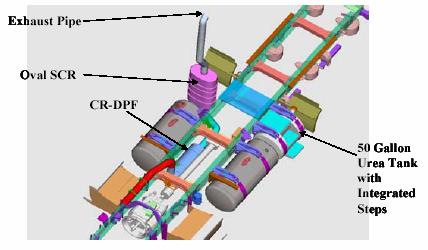
Lean NOx Catalysts
Controlling NOx emissions from a diesel engine is inherently difficult because diesel engines are designed to run lean. In the oxygen-rich environment of diesel exhaust, it is difficult to chemically reduce NOx to molecular nitrogen. The conversion of NOx to molecular nitrogen in the exhaust stream requires a reductant (HC, CO or H2) and under typical engine operating conditions, sufficient quantities of reductant are not present to facilitate the conversion of NOx to nitrogen.
Some lean NOx catalyst systems inject a small amount of diesel fuel or other reductant into the exhaust upstream of the catalyst. The fuel or other hydrocarbon reductant serves as a reducing agent for the catalytic conversion of NOx to N2. Other systems operate passively without any added reductant at reduced NOx conversion rates. A lean NOx catalyst often includes a porous material made of zeolite (a micro-porous material with a highly ordered channel structure), along with either a precious metal or base metal catalyst. The zeolites provide microscopic sites that are fuel/hydrocarbon rich where reduction reactions can take place. Without the added fuel and catalyst, reduction reactions that convert NOx to N2 would not take place because of excess oxygen present in the exhaust. Currently, peak NOx conversion efficiencies typically are around 10 to 30 percent (at reasonable levels of diesel fuel reductant consumption).
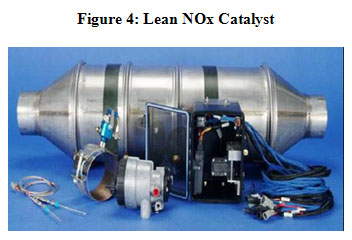
Exhaust Gas Recirculation (EGR)
Retrofitting exhaust gas recirculation on a diesel engine offers an effective means of reducing NOx emissions from the engine. Both low-pressure and high-pressure EGR systems exist but low-pressure EGR is used for retrofit applications because it does not require engine modifications.
As the name implies, EGR involves recirculating a portion of the engine’s exhaust back to the charger inlet or intake manifold, in the case of a naturally aspirated engines. In most systems, an intercooler lowers the temperature of the recirculated gases. The cooled recirculated gases, which have a higher heat capacity than air and contain less oxygen than air, lower combustion temperature in the engine, thus inhibiting NOx formation. Diesel particulate filters are always used with a low-pressure EGR system to ensure that large amounts of particulate matter are not recirculated to the engine. EGR systems are capable of achieving NOx reductions of more than 40 percent. A schematic of a low-pressure EGR+DPF retrofit system is shown in Figure 6.
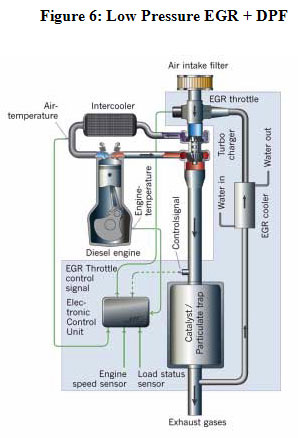
Crankcase Emission Control
Today, in most turbocharged aftercooled diesel engines, the crankcase breather is vented to the atmosphere often using a downward directed draft tube. While a rudimentary filter is often installed on the crankcase breather, substantial amount of particulate matter is released to the atmosphere. Emissions through the breather may exceed 0.7 g/bhp-hr during idle conditions on recent model year engines. For MY 1994 to 2006 heavy-duty diesel engines, crankcase PM emissions reductions provided by crankcase emission control technologies range from 0.01 g/bhp-hr to 0.04 g/bhp-hr or up to 25 percent of the tailpipe emission standards.
One solution to this emissions problem is the use of a multi-stage filter designed to collect, coalesce, and return the emitted lube oil to the engine’s sump. Filtered gases are returned to the intake system, balancing the differential pressures involved. Typical systems consist of a filter housing, a pressure regulator, a pressure relief valve and an oil check valve. These systems greatly reduce crankcase emissions. Figure 7 shows a schematic of a closed crankcase ventilation system.
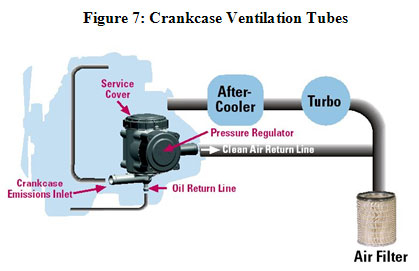
Emulsified Fuels
An alternative diesel fuel that reduces both PM and NOx emissions is an emulsion of diesel fuel and water. Emulsified diesel fuel is a blended mixture of diesel fuel, water and other additives. The water is suspended in droplets within the fuel, creating a cooling effect in the combustion chamber that decreases NOx emissions. A fuel-water emulsion creates a leaner fuel environment in the engine, lowering PM emissions. Emulsified diesel can be used in any diesel engine, but there is a decrease in power and fuel economy due to the fact that the addition of water reduces fuel energy content. Emulsified fuel can achieve emission reduction of NOx by about 10 to 20 percent and PM by about 50 to 60 percent.
An emulsified diesel + oxidation catalyst system (20 percent to over 40 percent reduction in NOx emissions and a greater than 50 percent reduction in PM emissions) has been verified as a retrofit technology option under both the EPA and ARB verification programs.
Biodiesel
Biodiesel is a domestically produced, renewable fuel that can be manufactured from new and used vegetable oils and animal fats. It is produced by reacting vegetable or animal fats with methanol or ethanol to produce a lower-viscosity fuel that is similar in physical characteristics to diesel, and which can be used neat or blended with petroleum diesel for use in a diesel engine. Biodiesel is commonly blended into petroleum-based fuel at low levels, i.e., 20 percent (B20) or less. Biodiesel can be used in its pure form (B100), but may require certain engine modifications to avoid maintenance and performance problems. Recently ASTM has developed specifications for B100 used as a fuel for mobile sources and specifications are under development for biodiesel blends like B20. Typical emissions benefits of B20 include a 10 percent decrease in CO, up to a 15 percent decrease in PM emissions, a 20 percent decrease in sulfate emissions, and a 10 percent decrease in HC emissions. In some tests, B20 has shown a slight increase in NOx emissions (about three percent) on some types of existing heavy-duty engines.
B20 has been verified as a retrofit technology option under the U.S. EPA’s Voluntary Retrofit Program. There is also growing experience with vehicles operating on biodiesel blends equipped with retrofit technologies like DOCs and DPFs. Retrofit DOCs and DPFs can operate effectively on vehicles using a biodiesel blend fuel up to B20 provided that this biodiesel blend conforms to appropriate biodiesel specifications (e.g., the available ASTM specifications for biodiesel) and that the biodiesel blend meets the fuel sulfur specification required by the retrofit technology supplier for that specific diesel retrofit technology.
